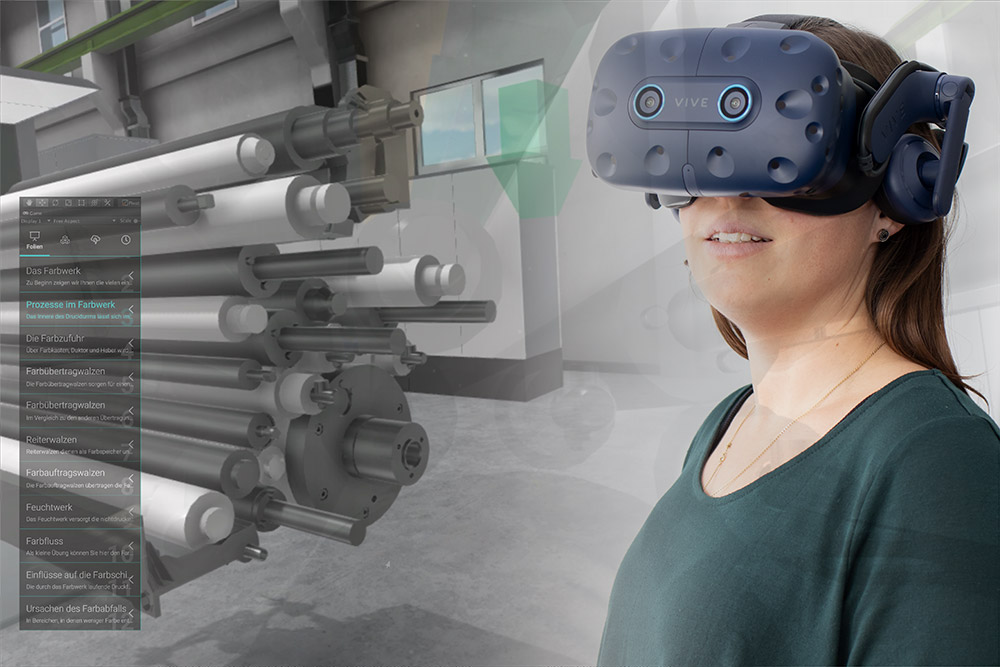Simply create your own technical training scenarios in Virtual Reality
Fraunhofer IGD of Rostock will be showcasing Machine@Hand 2.0, the beta version of its VR learning environment, at this year’s Hannover Messe. Machine@Hand 2.0 facilitates the creation of effective VR scenarios for training in the use of complex machinery, systems and technical processes. The VR learning environment is combined with an easy-to-use authoring tool. The VR modules can be readily integrated into existing LMS platforms and e-learning modules. VR learning environments are fully interactive and enable users to implement the learned content effectively and over the long term.

Highly complex machines, systems and technical processes have to keep working around the clock, and any downtime is costly in money terms. That is why the operation and maintenance of such systems require exceptionally well-trained personnel. Fraunhofer Institute for Computer Graphics Research IGD has developed Machine@Hand 2.0 as a virtual learning environment. Virtual reality (VR) is a simple and convenient approach to training users in the operation, assembly or maintenance of complex machinery and technical processes. One of the outstanding features of Machine@Hand 2.0 is the opportunity it presents for multiple learners to practice complex, decision-based scenarios together. In this way, team processes and collaborative action sequences can be trained – something that has never been done before in this format! In addition, instructors can provide remote support during an ongoing training session and give the trainees expert advice. The controlled and protected VR environment allows potentially hazardous actions and situations to be simulated for training purposes.
VR learning environments facilitate effective technical training
Virtual learning environments are a modern and highly effective approach to training. And not only because of the current constraints on classroom-based courses. Unlike learning media that are simply “consumed”, such as video or text/video/audio combinations, VR learning environments are wholly conceived and designed for learner interaction. This increases situational awareness and supports the processing and transfer of information into long-term memory, ensuring long-term learning success. Virtual reality provides scope for learners to access learning content efficiently, but with the added bonus of a fun element. Complex, problematic or dangerous courses of action can be repeated as often as desired on the virtual machine model within the simulated environment. Individual learning objectives are implemented in the VR environment in a straightforward way and help to reduce the user’s fear of contact with the technology for which he or she is being trained. Complex sequences of actions can be integrated into lively scenarios. In this way, learners internalize the appropriate behaviors and correct procedures for different situations.
Machine@Hand 2.0 opens up completely new possibilities for developing highly efficient VR training modules at a fraction of the cost and complexity of established solutions. In-house training departments, technical colleges and universities as well as providers of technical training content are especially likely to offer the ideal environment for the use of Machine@Hand 2.0. However, the application is not limited to purely technical training content. Complex training scenarios can also be developed for medicine, services and retail with the help of VR technology.
Creating VR training modules with Machine@Hand 2.0
In the latest release of the virtual training tool, VR modules can be created in an authoring environment that is very similar to the functionality and user interface of modern presentation programs. It will also be possible to create the training directly in VR by means of an authoring function that will soon become available. This eliminates the need for programming or expensive external service providers. CAD data and 3D models can be imported directly into the Machine@Hand 2.0 authoring tool and serve as templates for the elements in the VR learning environment. There exists a large number of libraries from which the most diverse elements can be combined to create complex learning scenarios. In this way, the creation of immersive and, above all, interesting VR learning content is made possible. It allows for easy integration into existing e-learning production processes and complements existing authoring tools with an effective VR component. Fraunhofer IGD has produced a video which provides potential customers with concrete impressions of how the VR learning environment looks from a user perspective at www.fh-igd.de/Machine-at-Hand. Visitors to the Fraunhofer IGD virtual stand at the Hanover Fair will be able to see the functionality for themselves. Bookings for networking appointments open on 25th March: www.hannovermesse.de/de/networking.
Technical requirements for the use of Machine@Hand 2.0
The technical requirements for the VR learning environment are at a level that corresponds to that of modern gaming computers. A current CPU with sufficient memory, a powerful graphics card and a VR set (VR goggles and hand controllers/paddles) suffice. VR training modules created with Machine@Hand 2.0 can be easily integrated into existing e-learning modules and technical platforms such as Learning Management Systems (LMS). The current standard xAPI interface will be supported later this year. The software can be readily integrated into an e-learning production process, e.g. one based on the ADDIE model. Machine@Hand supports the following 3D formats: FBX, GLTF, GLB, OBJ, STL, PLY, 3MF and Unity Asset Bundles.
If you are interested in Machine@Hand 2.0 and would like further information, please send an e-mail to machineathand@igd-r.fraunhofer.de. You have the opportunity to test a demo version of the authoring tool free of charge.
Further information:
- More about Machine@Hand (igd.fraunhofer.de)
 Fraunhofer Institute for Computer Graphics Research IGD
Fraunhofer Institute for Computer Graphics Research IGD